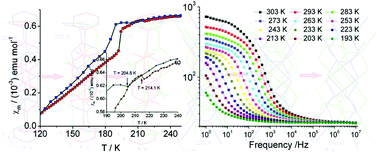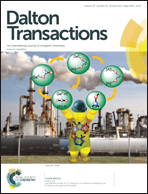Observation of hysteretic magnetic phase transitions coupled with orientation motion of ions and dielectric relaxation in a one-dimensional nickel-bis-dithiolene molecule solid†
Abstract
The second polymorph, the β-crystal, of the nickel-bis-dithiolene compound [4′-CF3bzPy][Ni(mnt)2], where 4′-CF3bzPy = 1-(4′-trifluoromethylbenzyl)pyridinium and mnt2− = maleonitriledithiolate, was obtained. The variable-temperature single crystal structures, magnetic behavior in 1.8–300 K and dielectric nature in 123–373 K have been investigated for the β-crystal. This polymorph experiences two hysteretic magnetic phase transitions in a narrow temperature region (190–217 K) with the thermal hysteresis loops ca. 6 K and ca. 11 K. The two hysteretic magnetic phase transitions are coupled with two isostructural phase transitions (IPTs), respectively, which are driven by the novel step-wise dynamic orientation motion of the anion and cation in the β-crystal. There is an absence of a dielectric anomaly in the structural transformation temperature interval. However, a dielectric relaxation, related to the dipole motion of polar CF3 groups in the cations under an ac electrical field, emerges in the high-temperature phase.


 Please wait while we load your content...
Please wait while we load your content...